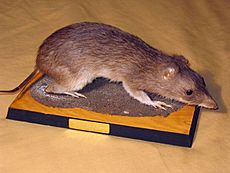Peramelemorphia facts for kids
Quick facts for kids PeramelemorphiaTemporal range: Oligocene – Recent
|
|
|---|---|
 |
|
| a short-nosed bandicoot | |
| Scientific classification | |
| Kingdom: | |
| Phylum: | |
| Class: | |
| Infraclass: | |
| Order: |
Peramelemorphia
Kirsch, 1968
|
| Families | |
|
Chaeropodidae Gill, 1872 |
|
The order Peramelemorphia includes the bandicoots and bilbies. These are small marsupials that eat both plants and animals, making them omnivores. This group of mammals has some animals you might not know much about. They live naturally in New Guinea and Australia.
Contents
What are Peramelemorphs?
Peramelemorphs are a special group of marsupials. Marsupials are mammals that carry their babies in a pouch. Think of kangaroos or koalas! Bandicoots and bilbies are smaller than those famous marsupials. They are known for their long, pointed snouts and strong claws. These features help them find food.
Where Do They Live?
Most peramelemorphs live in Australia. You can also find some types in New Guinea. They live in many different places. Some prefer dry, sandy areas. Others like forests or grasslands. Their homes can be quite varied, from deserts to wet woodlands.
What Do They Look Like?
Peramelemorphs are usually small to medium-sized. They have a body shape that looks a bit like a rat or a rabbit. Their fur can be grey, brown, or reddish. This helps them blend in with their surroundings. They have long, pointed noses. These noses are great for sniffing out food. They also have strong claws on their front feet. These claws are perfect for digging. Their tails are often thin and not very bushy.
What Do They Eat?
Bandicoots and bilbies are omnivores. This means they eat both plants and animals. Their diet includes many different things. They love to dig for insects and their larvae. They also eat worms, spiders, and other small creatures. Sometimes, they will munch on roots, seeds, and fruits. Their varied diet helps them survive in different environments.
How Do They Live?
Most peramelemorphs are nocturnal. This means they are active at night. During the day, they rest in burrows or nests. They dig these burrows themselves. Their strong claws are very useful for this. They are usually shy animals. They prefer to live alone. They use their excellent sense of smell to find food in the dark. They also use it to avoid predators.
Life Cycle and Reproduction
Like all marsupials, peramelemorphs give birth to very tiny, undeveloped babies. These babies are called joeys. After birth, the joeys crawl into their mother's pouch. They stay there to grow and develop. They drink milk from their mother inside the pouch. The pouch protects them as they grow bigger and stronger. Once they are old enough, they leave the pouch. They then start to explore the world on their own.
Types of Peramelemorphs
The Peramelemorphia order includes two main groups: bandicoots and bilbies. While they share many features, they also have some differences.
Bandicoots
Bandicoots are the most common type of peramelemorph. There are many different species of bandicoots. They vary in size and color. Most bandicoots have short ears. They are known for their quick movements. They often leave small, cone-shaped holes in the ground. These holes show where they have been digging for food.
Bilbies
Bilbies are larger than most bandicoots. They have very long ears. These ears help them hear predators from far away. They also help them keep cool in hot climates. Bilbies have long, black and white tails. They are excellent diggers. They create deep burrows that can be several meters long. These burrows provide shelter from the heat and predators.
Are They in Danger?
Sadly, many species of bandicoots and bilbies are facing threats. Some are even endangered. This means they are at risk of disappearing forever. The main threats include habitat loss. Their homes are being destroyed by human activities. Predators like foxes and feral cats also hunt them. Conservation efforts are underway to protect these unique marsupials. People are working to save their habitats and control predator numbers.
See also
 In Spanish: Perameleformes para niños
In Spanish: Perameleformes para niños

